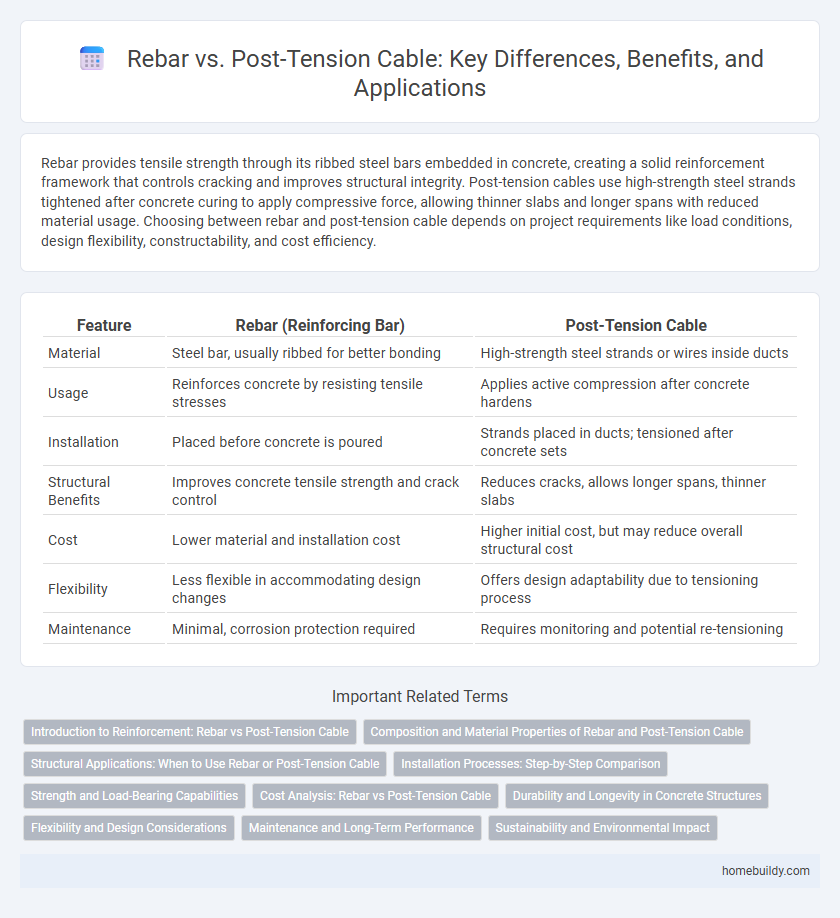Rebar provides tensile strength through its ribbed steel bars embedded in concrete, creating a solid reinforcement framework that controls cracking and improves structural integrity. Post-tension cables use high-strength steel strands tightened after concrete curing to apply compressive force, allowing thinner slabs and longer spans with reduced material usage. Choosing between rebar and post-tension cable depends on project requirements like load conditions, design flexibility, constructability, and cost efficiency.
Table of Comparison
| Feature | Rebar (Reinforcing Bar) | Post-Tension Cable |
|---|---|---|
| Material | Steel bar, usually ribbed for better bonding | High-strength steel strands or wires inside ducts |
| Usage | Reinforces concrete by resisting tensile stresses | Applies active compression after concrete hardens |
| Installation | Placed before concrete is poured | Strands placed in ducts; tensioned after concrete sets |
| Structural Benefits | Improves concrete tensile strength and crack control | Reduces cracks, allows longer spans, thinner slabs |
| Cost | Lower material and installation cost | Higher initial cost, but may reduce overall structural cost |
| Flexibility | Less flexible in accommodating design changes | Offers design adaptability due to tensioning process |
| Maintenance | Minimal, corrosion protection required | Requires monitoring and potential re-tensioning |
Introduction to Reinforcement: Rebar vs Post-Tension Cable
Rebar, short for reinforcing bar, is a steel bar used to strengthen concrete by providing tensile strength and enhancing structural integrity. Post-tension cables, made from high-strength steel strands, are tensioned after concrete hardening to induce compressive stresses, improving load-bearing capacity and reducing cracking. Unlike rebar's static reinforcement, post-tension cables enable active load control, allowing for longer spans and thinner concrete sections in construction projects.
Composition and Material Properties of Rebar and Post-Tension Cable
Rebar is typically composed of carbon steel with a high tensile strength and ribbed surface to enhance bonding with concrete, offering excellent durability and flexibility under tension. Post-tension cables are made from high-strength, low-alloy steel strands that are coated with corrosion-resistant materials such as grease and plastic sheathing to withstand significant tensile forces after concrete curing. The key material difference lies in rebar's rigidity and reliance on direct concrete bonding versus the post-tension cable's specialized alloy and protective coatings designed to maintain tension within ducts.
Structural Applications: When to Use Rebar or Post-Tension Cable
Rebar is ideal for structural applications requiring rigid reinforcement in concrete slabs, beams, and columns to resist tensile forces and prevent cracking under static loads. Post-tension cable is preferred in situations demanding enhanced slab performance, reduced thickness, or longer spans, such as bridges and high-rise buildings, where controlled tensioning improves load distribution and minimizes deflection. Selecting between rebar and post-tension cable depends on structural requirements, load conditions, and design goals for durability and efficiency.
Installation Processes: Step-by-Step Comparison
Rebar installation involves cutting, bending, tying, and placing steel bars in the formwork before concrete pouring, requiring manual labor and precise positioning to ensure structural integrity. Post-tension cable installation includes placing ducts within the concrete form, threading cables through the ducts after concrete hardening, and tensioning the cables using hydraulic jacks to apply compressive forces. The rebar process is labor-intensive with fixed placement, whereas post-tension cables offer flexibility in tensioning after the concrete has set, impacting project timelines and structural performance.
Strength and Load-Bearing Capabilities
Rebar offers high tensile strength and excellent load-bearing capacity by reinforcing concrete structures to resist cracking under tension. Post-tension cables provide superior strength through tensioning processes that actively compress concrete, enhancing its load-bearing capacity and minimizing deflection. Comparing both, post-tension cables allow for longer spans and thinner slabs, while rebar is more effective in evenly distributing loads in standard concrete applications.
Cost Analysis: Rebar vs Post-Tension Cable
Rebar typically offers lower material and installation costs compared to post-tension cables, making it a budget-friendly choice for many concrete reinforcement projects. Post-tension cable systems, while more expensive initially, can reduce overall project costs through reduced concrete volume and thinner slab designs, leading to long-term savings. Cost efficiency depends on project scale, structural requirements, and labor availability, with post-tension cables favoring larger or more complex structures.
Durability and Longevity in Concrete Structures
Rebar offers high durability and longevity in concrete structures by providing robust tensile strength and resistance to cracking under stress conditions. Post-tension cables enhance durability by reducing concrete cracking and controlling deflection but require vigilant maintenance to prevent corrosion and ensure long-term performance. Comparing both, rebar generally delivers consistent longevity with lower maintenance demands, while post-tension cables offer superior stress management but depend heavily on protective measures against environmental degradation.
Flexibility and Design Considerations
Rebar offers rigid reinforcement with predictable tensile strength, making it ideal for straightforward structural designs requiring uniform load distribution. Post-tension cables provide enhanced flexibility by allowing adjustments in tension post-installation, which supports longer spans and thinner slabs while reducing material usage. Design considerations between rebar and post-tension cables hinge on project requirements such as load conditions, span lengths, and construction timelines, where post-tensioning can optimize performance in complex architectural forms.
Maintenance and Long-Term Performance
Rebar requires regular inspection for corrosion and potential cracking, necessitating periodic maintenance to ensure structural integrity over time. Post-tension cables, encased in protective ducts, generally exhibit superior resistance to corrosion, reducing maintenance frequency and enhancing long-term durability. The choice between rebar and post-tension cables significantly impacts lifecycle costs and structural longevity in construction projects.
Sustainability and Environmental Impact
Rebar, made from steel, has a high recycling rate which significantly reduces its environmental footprint compared to post-tension cables often made from high-strength steel strands with more intensive manufacturing processes. The carbon emissions associated with producing rebar are generally lower due to widespread recycling and less energy-intensive fabrication. While post-tension cables offer structural advantages, rebar's sustainable lifecycle and recyclability make it a more environmentally friendly choice in construction projects focused on reducing carbon impact.
Rebar vs Post-Tension Cable Infographic

 homebuildy.com
homebuildy.com